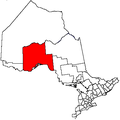Leeblain
Leeblain | |
|---|---|
Leeblain is a
History
The town Leeblain[1] was created back in 1893 as a stop on the Port Arthur, Duluth and Western Railway (mile 83).[2] Leeblain was named after two Toronto businessmen who were important investors in the railway, Arthur Brindley Lee (Rice, Lewis & Son) and Hugh Blain (Eby, Blain & Co.). It was hoped that the town would grow into a "metropolis" because of the business generated by the iron mines immediately across the border in Minnesota that were part of the Gunflint Range. The railway planned for Leeblain to be its major terminal point outside of Port Arthur, with a roundhouse and other maintenance facilities.[3]


Located at Leeblain was a framed station that measured 20 by 40 feet and a 1200-foot siding.[4] There was also a two-storey hotel/trading post, as well as several smaller buildings. The town site was also used as a worker camp during the construction of the railway, and some of the Italian labourers built rock ovens to bake their bread.[5][6] The hotel at Leeblain was operated for a time by Adolph Perras who was previously a businessman in the town of Port Arthur.
With the collapse of the
Today
See also
- Silver Mountain Station
- North Lake Station
References
- ^ Carter, Floreen. Place Names of Ontario. London; Phelps Pub, 1984
- ^ Lovell's Gazetteer of British North America. Montreal; J. Lovell & Son, 1895.
- ^ Thunder Bay Daily Sentinel January 6, 1893; Fort William Journal January 7, 1893
- ^ Fort William Journal November 16, 1892
- ^ Fort William Journal November 5, 1892
- ^ Le Blaine-A Border Ghost Town Minnesota History News, vol.3, June 1962
- ^ Chronology of the PAD&W Railway
- ^ Sessional Papers of the Dominion of Canada. Statement of Custom Revenue Collected-Ontario: Annual Reports of the Customs Dept 1904-1910
- ^ Raff, Willis. Pioneers in the Wilderness Grand Marais; Cook Cty HS, 1981
- ^ Le Blaine-A Border Ghost Town Minnesota History News, vol.3, June 1962
- ^ Thunder Bay Chronicle-Journal July 5, 1999
- ^ Thunder Bay Chronicle-Journal May 13, 2007
- ^ Star Tribune Story on the Gunflint Fire Archived 2008-07-20 at the Wayback Machine
External links
- "Leeblain"
- "Leeblain", by D. Battistel. Ontario Abandoned Places.
- "Port Arthur, Duluth and Western Railway, Leeblain, ON 1997", by D. Battistel. YouTube.
- "Rock ovens and Railway siding, Port Arthur, Duluth and Western Railway, Leeblain, ON", by D. Battistel. YouTube.
- "Port Arthur, Duluth and Western Railway, Leeblain, ON 2012", by D. Battistel. YouTube.
- "Port Arthur, Duluth and Western Railway, Leeblain, ON 2013", by D. Battistel. YouTube.

